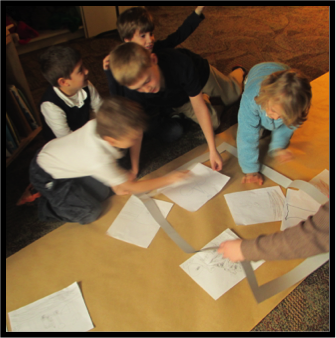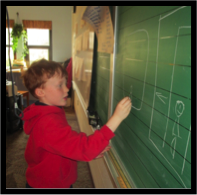The Life of a Video Game
In the Fall of 2012, our bookclub gathered daily to read the book Horten's Miraculous Mechanisms. We enjoyed reading about the main character, Stuart, and his adventures while he searched for his Great Uncle Tony's magic workshop.
When we finished the book, we debated how to represent our thinking. The ultimate goal of our project-work was to deepen our understandings of the connection between reading, writing, literacy, and the arts and then share our expertise with the greater school community. The group of boys brainstormed over several days, and the idea of creating a video game had a persistent presence.
While the idea was intriguing to all, the obvious roadblock of how to actually create a video game consumed our discussion for days. Their solutions implied youthful simplicity.
- Ask the arcade man.
- Look it up.
- Just go to Dave and Busters.
- Have a company bring it in. Like Fed Ex.
- Go on Safari. Find out what company makes video games.
- Or Brighthouse Networks. What is Brighthouse Networks?
The enthusiasm of the group took precedence over their pragmatism. Even though we discussed the fact that we did not have any practical means to develop our own video game, each child became engrossed in the fantasy of what it could be like.
All of our ideas gather so much momentum, we reach out to a computer programmer who listens to our ideas and tells us exactly what we hoped to hear:
“That's doable.”
What is a Game?
We talked about what makes a game. We talked about soccer and chess. For example in soccer:
- A game has a goal.
- The goal is to score more points than the other team
- A game has rules that constrain how you can play it.
- You can only touch the ball with your feet
- You have to stay in bounds.
- You have to kick the ball through the goal to score.
- A game has obstacles and challenges that make it difficult to achieve the goal.
- The other team is trying to score goals and you need to prevent them from doing so.
- The other team is trying to prevent your team from scoring goals.
Building Our Game
Making choices collaboratively requires us to debate, question, and challenge each other. Over time, we come to a consensus and begin dividing the game into segments.



What is the goal of our game?

How do we achieve the goal?

How can we make it harder to achieve the goal?

Computer Jon offers support and leaves us with many decisions to make and tasks to complete.
“You have to do a lot of work. It doesn't take one person to build a video game.”
Nathan



Our game really began to take shape once we had our decisions and drawings made.
“Computer Jon helped us and told us how we would make it and stuff. We made all the places where Stuart went in order.”
Andrew

We added color on the computer to our scanned drawings and put them in an order that matches the book.

The game starts with a scene of Stuart's house drawn by Noah.

Players then travel to Reid's drawing of the town library.

Lucas' sketch of the train station offers many opportunities for adventures.

Andrew's drawing of the warehouse apartment shows some of the details from the book.

Uncle Tony's house is drawn by Spencer, including the chimney where a secret is hidden.

Jonah drew his interpretation of exhibits at the museum.

The video game ends with Nathan's drawing of Uncle Tony's workshop.
I've learned that making video games is hard. It is hard because you have to draw a lot. And if we actually made the screen and everything it would be really hard. It wouldn't be easy unless you are really skilled at it. I hope people will think that it's pretty cool that a 7 year old made a video game.
Jonah